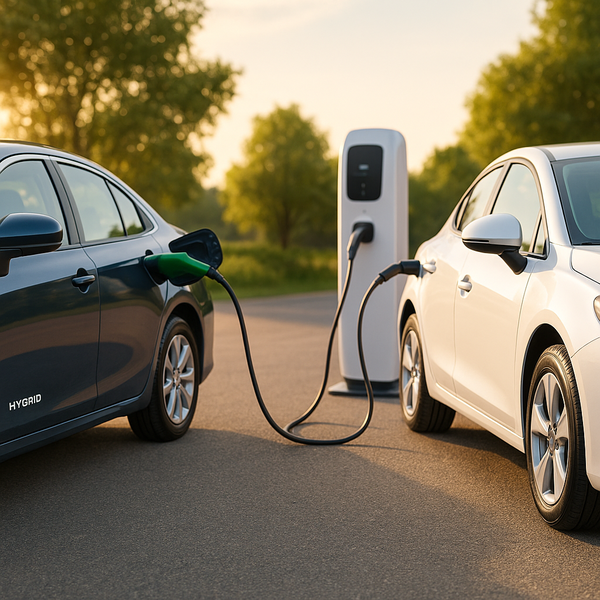
Choosing a new car today involves navigating a landscape rapidly shifting towards electrification. Two dominant options stand out: hybrid electric vehicles (HEVs) and battery electric vehicles (BEVs). While both aim to reduce reliance on traditional gasoline engines, they employ fundamentally different technologies to achieve this goal. Understanding these differences is crucial for making an informed decision based on your lifestyle, driving habits, and priorities.
How Hybrid Cars Work
Hybrid electric vehicles combine an internal combustion engine (typically gasoline) with one or more electric motors and a battery pack. The car's computer system intelligently manages power delivery from these sources, often using electric power at low speeds, gasoline power at higher speeds, or a combination of both. Some hybrids can recharge their batteries through regenerative braking, capturing energy normally lost during deceleration.
There are different types of hybrids. Standard (or 'self-charging') hybrids cannot be plugged in; their battery is charged by the gasoline engine and regenerative braking. Plug-in Hybrid Electric Vehicles (PHEVs) have larger batteries that can be charged from an external power source and typically offer a significant all-electric driving range before the gasoline engine kicks in. Mild hybrids use a small electric motor primarily to assist the gasoline engine and provide features like enhanced stop-start, but they cannot drive on electric power alone for any significant distance.
Understanding Electric Cars (BEVs)
Battery Electric Vehicles (BEVs) run entirely on electricity stored in a large battery pack. They have one or more electric motors but no gasoline engine or fuel tank. BEVs are powered solely by the electricity drawn from the grid, typically through charging stations or home chargers. They produce zero tailpipe emissions, making them a popular choice for those prioritizing environmental impact.
The range of a BEV depends on its battery size and efficiency, varying from under 100 miles for older or smaller models to well over 300 or even 400 miles for newer vehicles. Charging infrastructure is a key consideration for BEV owners, requiring access to charging points at home, work, or public locations. Charging times vary significantly depending on the charger type (Level 1, Level 2, or DC fast charging) and the car's battery capacity.
Comparing Fueling/Charging
One of the most significant differences lies in how you power these vehicles. Hybrid cars, even PHEVs, offer the convenience of refueling at a standard gasoline station when the electric range is depleted. For standard hybrids, this is the only external power source needed. PHEVs add the option of plugging in, which is essential to maximize their electric driving range and efficiency.
Electric cars, conversely, rely entirely on electricity. This requires a shift in mindset regarding 'refueling'. Instead of a quick stop at a gas station, charging often happens overnight at home, during work, or while running errands using public chargers. DC fast chargers can add significant range quickly, but availability varies. Access to reliable charging, especially home charging, is a critical factor for BEV ownership.
Performance and Driving Experience
Both hybrid and electric cars generally offer a smoother, quieter driving experience compared to traditional gasoline cars, especially at lower speeds. Electric motors provide instant torque, resulting in quick acceleration, which is particularly noticeable in BEVs.
Hybrid cars seamlessly transition between gasoline and electric power, which can sometimes be felt but is often very smooth in modern vehicles. PHEVs offer the quiet, powerful acceleration of electric driving for their initial range, then operate like a standard hybrid. BEVs provide a consistently quiet and responsive ride, with no engine noise or gear shifts (as they typically use a single-speed transmission).
Costs: Purchase, Fuel, and Maintenance
Comparing the costs involves looking beyond the sticker price. Hybrid cars often have a higher purchase price than comparable gasoline-only models, but less than equivalent BEVs. PHEVs are generally more expensive than standard hybrids.
Fuel costs are where electrified vehicles often shine. Electricity is typically cheaper per mile than gasoline, leading to lower 'fueling' costs for BEVs and PHEVs (when running on electric power). Standard hybrids offer better fuel economy than gasoline cars, resulting in lower gas bills.
Maintenance tends to be lower for electric cars. With fewer moving parts (no engine oil, spark plugs, exhaust system, etc.), there are fewer things to service or replace. Regenerative braking also reduces wear on brake pads. Hybrid cars still require gasoline engine maintenance but benefit from reduced wear on some components when operating on electric power.
Environmental Impact
From a tailpipe emissions perspective, BEVs are the clear winner, producing zero emissions. The overall environmental impact of a BEV depends on how the electricity is generated. Charging with renewable energy sources significantly reduces its carbon footprint.
Hybrid cars, while still using gasoline, produce fewer emissions than comparable gasoline-only cars due to their improved fuel efficiency and ability to operate on electric power part-time. PHEVs, especially when regularly charged and driven on electricity, have a significantly lower environmental impact than standard hybrids or gasoline cars.
Which Vehicle is Right for You?
The choice between a hybrid and an electric car depends heavily on individual circumstances. An electric car might be ideal if you have reliable access to charging (especially home charging), typically drive within a BEV's range for daily commutes, and prioritize the lowest running costs and zero tailpipe emissions. They are excellent for urban and suburban driving.
A hybrid (standard or PHEV) might be a better fit if you frequently take long road trips, have limited access to charging, or want better fuel economy without the commitment to full electric vehicle ownership. Standard hybrids require no change in fueling habits. PHEVs offer a transition, allowing electric driving for short trips while having the gasoline engine backup for longer journeys or when charging isn't convenient.
Ultimately, both hybrid and electric vehicles represent steps towards a more sustainable automotive future. Evaluating your typical driving distances, access to charging, budget, and environmental goals will guide you to the best choice between these two increasingly popular options.

